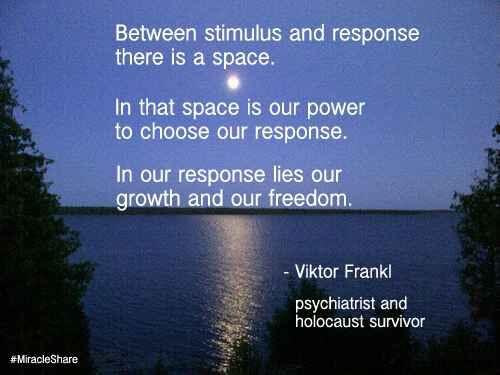
“Between Stimulus and Response There Is a Space.
In That Space Is Our Power To Choose Our Response”
That quote is attributed to Viktor Frankl, author of “Man’s Search for Meaning”, the most personally impactful book I’ve ever read.
Two recent meetings have had me think about this “space between stimulus and response”, about the “the power of the pause”. about our freedom to make choices, including our choice on how to respond to external stimuli.
One meeting was at an art exhibit, where being among amazing portraiture contributed to a sparkling conversation on many topics. One theme was on the power of choice. After that meeting, I mused on Frankl and this famous quote around choice.
As it turns out, the quote above was not made by Frankl, but in discussing Frankl’s famous book, it was made by another master, Stephen Covey.
The quote that had Covey develop his own and that does come from Frankl’s book was this one, which when I read it for the first time gave me goosebumps all over.
“Forces beyond your control can take away everything you possess except one thing, your freedom to choose how you will respond to the situation. You cannot control what happens to you in life, but you can always control what you will feel and do about what happens to you.”
I distilled this for myself to: “the ultimate freedom is choice”
Now, to the second recent meeting. I had a fascinating and wide-ranging conversation with a young British Army officer. One story he told was about how the Army had studied decision making under fire. Literally under enemy fire. In such situations, what they found was that the decision maker was having to process so many different variables in such radically stressful situations that sometimes they would forget their training and make decisions contrary to their training and the best interests of their men and the situation.
What the Army identified was that even a brief pause would be of huge value in the decision making process. Given the squad leaders would often be hiding from enemy fire in terrible conditions, they simply made a laminated card with a few key questions for the person to ask and answer of and for themselves.
Apparently, this takes less than twenty seconds for them to pull the card out of their pocket and run through the questions, yet this twenty second pause created the opportunity to reconnect to what they had been trained to do, then to make a choice from response rather than reaction.
I found these lessons very valuable and, serendipitously, have applied them since on calls with one or two clients who have found themselves under stress.
We always have a choice, and this recognition can be amplified by recognising the “power of the pause” and consciously pausing.
“Between Stimulus and Response There Is a Space.
In That Space Is Our Power To Choose Our Response”
